DeWalt D51822 Handleiding
DeWalt
Nietmachine
D51822
Bekijk gratis de handleiding van DeWalt D51822 (7 pagina’s), behorend tot de categorie Nietmachine. Deze gids werd als nuttig beoordeeld door 77 mensen en kreeg gemiddeld 5.0 sterren uit 39 reviews. Heb je een vraag over DeWalt D51822 of wil je andere gebruikers van dit product iets vragen? Stel een vraag
Pagina 1/7

INSTRUCTION MANUAL
GUIDE D’UTILISATION
MANUAL DE INSTRUCCIONES
INSTRUCTIVO DE OPERACIÓN, CENTROS DE SERVICIO
Y PÓLIZA DE GARANTÍA. ADVERTENCIA: LÉASE ESTE
INSTRUCTIVO ANTES DE USAR EL PRODUCTO.
DEWALT Industrial Tool Co., 701 East Joppa Road, Baltimore, MD 21286
(JAN10) Part No. N066407 D51822, D51844
Copyright © 2003, 2006, 2007, 2008, 2009, 2010
The following are trademarks for one or more D WALT power tools: the yellow and black color scheme; E
the “D” shaped air intake grill; the array of pyramids on the handgrip; the kit box configuration; and the
array of lozenge-shaped humps on the surface of the tool.
IF YOU HAVE ANY QUESTIONS OR COMMENTS ABOUT THIS OR ANY D WALT TOOL, CALL US E
TOLL FREE AT: 1-800-4-DEWALT (1-800-433-9258)
POUR TOUTE QUESTION OU REMARQUE AU SUJET DE CET OUTIL OU DE TOUT AUTRE OUTIL
DEWALT, COMPOSEZ LE NUMÉRO SANS FRAIS : 1 800 4-DEWALT (1 800 433-9258)
SI TIENE ALGUNA PREGUNTA O DESEA HACER ALGÚN COMENTARIO SOBRE ESTA O CUALQUIER
OTRA HERRAMIENTA DEWALT, LLAME SIN COSTO AL: 1-800-4-DEWALT (1-800-433-9258)
SAVE THESE INSTRUCTIONS
Important Safety Instructions for Pneumatic Tools
WARNING: When using any pneumatic tool, all safety precautions, as outlined below,
should be followed to avoid the risk of death or serious injury. Read and understand all
instructions before operating the tool.
CONSERVER CES DIRECTIVES
Consignes de sécurité importantes pour les outils
pneumatiques
AVERTISSEMENT : Lorsqu’on utilise un outil pneumatique, toutes les mesures de
sécurité mentionnées ci-dessous doivent être respectées pour éviter les risques de
blessures sérieuses ou de mort. Il faut lire et comprendre toutes les directives avant de faire
fonctionner l’outil.
CONSERVE ESTAS INSTRUCCIONES
Instrucciones importantes de seguridad para las
herramientas neumáticas
ADVERTENCIA: Cuando utilice una herramienta neumática, debe seguir todas las precau-
ciones de seguridad descritas a continuación, con el fin de evitar el riesgo de muerte o lesiones
graves. Lea todas las instrucciones hasta comprenderlas antes de operar la herramienta.
D51822 (31˚ Clipped Head), D51844 (20˚ Full Round Head) Framing Nailers
Cloueurs pour charpentes, modèles D51822 (clous à tête entaillée de 31 ˚)
et D51844 (clous à tête ronde ppleine de 20 ˚)
Clavadoras D51822 (31˚ media cabeza), D51844 (20˚ cabeza redonda completa)
EXTERNAL TOOL PARTS
PIÈCES EXTERNES DE L’OUTIL
PIEZAS EXTERNAS DE LA HERRAMIENTA
• La mise en marche de l’outil peut projeter
des débris, du matériel amalgamé ou de la
poussière pouvant causer des blessures
oculaires à l’opérateur. L’opérateur et toutes
les personnes dans la zone environnante
doivent porter des lunettes de sécurité avec
écrans latéraux fixes. Les lunettes de sécurité
approuvées sont estampillées avec la mention
“Z87.1”. L’employeur a la responsabilité d’imposer
à l’opérateur et à toutes autres personnes dans la
zone de travail le port d’équipement de protection
des yeux. (fig. A)
• Toujours porter des protecteurs d’oreilles
appropriés et autres dispositifs de protection
durant l’utilisation. Selon les conditions et la
durée d’utilisation, le bruit émis par cet outil peut
causer une perte auditive. (fig. A)
• Utiliser uniquement de l’air propre, sec et régulé.
La conden sation provenant d’un compresseur d’air
peut faire rouiller et endommager les composantes
internes de l’outil. (fig. B)
• Réguler la pression d’air. Utiliser une pression
compatible avec la pression nominale indiquée
sur la fiche signalétique de l’outil. (Ne doit pas
excéder 120 psi, 8,3 bars.) Ne pas raccorder
l’outil à un compresseur d’une puissance
nominale supérieure à 175 psi. La pression de
fonctionnement de l’outil ne doit jamais excéder
175 psi même dans l’éventualité d’une défaillance
du régulateur. (fig. C)
• Utiliser exclusivement un tuyau d’air prévu
pour une pression de fonctionnement
maximale d’au moins 10,3 bars (150 psi) ou
150 % de la pression maximale du système,
selon la pression la plus élevée. (Fig. D)
• Ne pas utiliser de gaz en bouteille pour faire
fonctionner cet outil. Les gaz comprimés
en bouteille comme l’oxygène, le bioxyde de
carbone, l’azote, l’hydrogène, le propane,
l’acétylène ou l’air ne doivent pas être utilisés
avec les outils pneumatiques. Ne jamais utiliser
de gaz combustibles ou tout autre type de gaz
réactif comme source d’énergie pour cet outil.
Leur utilisation représente un danger d’explosion
et peut se solder par des blessures corporelles.
(fig. E)
• Utiliser des raccords qui libèrent toute la
pression de l’outil lorsqu’il est débranché de la
source d’alimentation. Utiliser des connecteurs
de tuyau qui coupent l’alimentation d’air du
compresseur quand l’outil est débranché. (fig. F)
• Débrancher l’outil de la source d’alimentation
en air lorsqu’il n’est pas utilisé. Toujours
débrancher l’outil de la source d’alimentation
en air et retirer les attaches qui se trouvent
• Actuating tool may result in flying debris,
collation material, or dust which could harm
operator’s eyes. The operator and all those
persons in the general area should wear safety
glasses with permanently attached side shields.
Approved safety glasses are imprinted with
the characters “Z87.1”. It is the employer’s
responsibility to enforce the use of eye protection
equipment by the tool operator and other people
in the work area. (Fig. A)
• Always wear appropriate personal hearing
and other protection during use. Under some
conditions and duration of use, noise from this
product may contribute to hearing loss. (Fig. A)
• Use only clean, dry, regulated air. Conden sation
from an air compressor can rust and damage the
internal workings of the tool. (Fig. B)
• Regulate air pressure. Use air pressure
compatible with ratings on the nameplate of
the tool. (Not to exceed 120 psi, 8.3 bar) Do not
connect the tool to a compressor rated at over
175 psi. The tool operating pressure must never
exceed 175 PSI even in the event of regulator
failure. (Fig. C)
• Only use air hose that is rated for a maximum
working pressure of at least 150 PSI
(10.3 BAR) or 150% of the maximum system
pressure, which ever is greater. (Fig. D)
• Do not use bottled gases to power this tool.
Bottled compressed gases such as oxygen,
carbon dioxide, nitrogen, hydrogen, propane,
acetylene or air are not for use with pneumatic
tools. Never use combustible gases or any other
reactive gas as a power source for this tool.
Danger of explosion and/or serious personal
injury may result. (Fig. E)
• Use couplings that relieve all pressure from
the tool when it is disconnected from the
power supply. Use hose connectors that shut
off air supply from compressor when the tool is
disconnected. (Fig. F)
• Disconnect tool from air supply when not in
use. Always disconnect tool from air supply
and remove fasteners from magazine before
leaving the area or passing the tool to another
operator. Do not carry tool to another work
area in which changing location involves
the use of scaffoldings, stairs, ladders, and
the like, with air supply connected. Do not
make adjustments, remove magazine, perform
maintenance or clear jammed fasteners while
connected to the air supply. If the contact trip
• El funcionamiento de la herramienta puede
despedir residuos, material de colación
o polvo, que podrían dañar los ojos del
operador. El operador y todas las personas
cercanas deben llevar lentes de seguridad con
protectores laterales permanentes. Los lentes
de seguridad certificados se distinguen por los
caracteres impresos “Z87.1”. Es responsabilidad
del empleador asegurarse de que tanto el
operador de la herramienta como las personas
situadas en el área de trabajo utilicen equipos
de protección ocular. (Fig. A)
• Utilice siempre la apropiada protección,
tanto auditiva como de otro tipo, durante la
utilización. En determinadas condiciones y con
utilizaciones prolongadas, el ruido generado
por este producto puede contribuir a la pérdida
de audición. (Fig. A)
• Utilice solamente aire limpio, seco y regulado.
La condensación debida al compresor de aire
puede oxidar y dañar las piezas internas de la
herramienta. (Fig. B)
• Regule la presión del aire. Utilice una presión
compatible con los valores indicados en la
placa de características. (No debe exceder de
120 psi, 8.3 bar.) No conecte la herramienta a
un compresor con un valor superior a 175 psi.
La presión de funcionamiento de la herramienta
no debe exceder nunca los 175 psi, incluso en
el caso de que falle el regulador. (Fig. C)
• Utilice únicamente una manguera de aire que
tenga una capacidad nominal para una presión
de trabajo máxima de 10,3 BAR (150 PSI),
como mínimo, o el 150% de la presión máxima
del sistema, el valor que sea mayor. (Fig. D)
• No utilice gas embotellado para suministrar
energía a esta herramienta. Los gases
comprimidos y embotellados, como el oxígeno, el
dióxido de carbono, el nitrógeno, el hidrógeno, el
propano, el acetileno o el aire no se deben usar
para las herramientas neumáticas. Nunca utilice
gases combustibles o cualquier otro gas reactivo
como fuente de energía para esta herramienta.
Podría provocarse un peligro de explosión y/o
lesiones personales graves. (Fig. E)
• Utilice conexiones que alivien toda la presión
de la herramienta cuando se desconecte de
la toma de corriente. Utilice conectores de
mangueras que bloqueen el suministro de aire del
compresor cuando la herramienta se desconecte.
(Fig. F)
• Desconecte la herramienta del suministro
de aire cuando no se vaya a usar. Siempre
desconecte la herramienta del suministro
de aire y retire los clavos del cargador antes
PUSHER
POUSSOIR
LIBERADOR DEL PROPULSOR
MAGAZINE
MAGASIN
DEPÓSITO
TRIGGER
DÉTENTE
GATILLO
CONTACT TRIP
DÉCLENCHEUR
ACTIVADOR POR
CONTACTO
DEPTH
SETTING
RÉGLAGE DE LA
PROFONDEUR
AJUSTE DE LA
PROFUNDIDAD
EXHAUST
ÉCHAPPEMENT
CÁMARA DE
ESCAPE
D51822 Clipped Head D51844 Full Round Head
Clous à tête entaillée Clous à tête ronde pleine
Media cabeza Cabeza redonda completa
Height - Hauteur - Altura 12-3/4" (32.4 cm) 12-3/4" (32.4 cm)
Width - Largeur - Anchura 5’’ (12.7 cm) 5’’ (12.7 cm)
Length - Longeur - Longitud 18-5/8" (47.3 cm) 20-3/4" (52.7 cm)
Weight - Poids - Peso 7.3 lb (3.40 kg) 7.4 lb (3.44 kg)
Magazine Angle
Angle du magasin 31˚ 20˚
Ángulo del depósitor
Recommended Operating Pressure
Pression de fonctionnement 70 - 120 psig 70 - 120 psig
recommandée (4.9 to 8.3 bar, (4.9 to 8.3 bar,
Presión de funcionamiento 5 to 8.5 kg/cm
2) 5 to 8.5 kg/cm2)
recomendada
Air consumption per 100 cycles 7.2 cfm @ 100 psi 7.2 cfm @ 100 psi
Consommation d’air par 100 cycles 203.9 l/m @ 6.9 bar 203.9 l/m @ 6.9 bar
Consumo de aire por cada 100 ciclos
Air consumption per single shoot .072 cfm @ 100 psi .072 cfm @ 100 psi
Consommation d’air par coup 2.039 l/m @ 6.9 bar 2.039 l/m @ 6.9 bar
Consumo de aire por cada disparo
Loading capacity Up to 80 Nails Up to 65 Nails
Capacité de chargement Jusqu’à 80 clous Jusqu’à 65 clous
Capacidad de carga Hasta 80 clavos Hasta 65 clavos
TOOL SPECIFICATIONS
CARACTÉRISTIQUES DE L’OUTIL
ESPECIFICACIONES DE LA HERRAMIENTA
FIG. A
FIG. B
FIG. C
FIG. D
FIG. E
FIG. F
If you have questions or comments, contact us.
Pour toute question ou tout commentaire, nous contacter.
Si tiene dudas o comentarios, contáctenos.
1-800-4-D WALT • www.dewalt.com-
D51822 Clipped Head D51844 Full Round Head
Clous à tête entaillée Clous à tête ronde pleine
Media cabeza Cabeza redonda completa
Nail Lengths
Longueurs des clous 2" - 3-1/2" (50 mm - 90 mm) 2" - 3-1/2" (50 mm - 90 mm)
Longitud de los clavos
Shank Diameters
Diamètres de la tige .113" - .131" (2.9 mm - 3.3 mm) .113" - .148" (2.9 mm - 3.8 mm)
Diámetro del cuerpo
Nail Stick Angles
Angles des bandes de clous 30˚ - 34˚ 20˚ - 22˚
Ángulos de los clavos
Shank Types Smooth, Ring, Screw Smooth, Ring, Screw
Types de tige Doux, Anneau, Vis Doux, Anneau, Vis
Tipos de cuerpo Liso, anillado, espiral Liso, anillado, espiral
NAIL SPECIFICATIONS
CARACTÉRISTIQUES DES CLOUS
ESPECIFICACIONES DE LOS CLAVOS
Definitions: Safety Guidelines
The definitions below describe the level of severity for
each signal word. Please read the manual and pay atten-
tion to these symbols.
DANGER: Indicates an imminently hazardous situation
which, if not avoided, result in will death or serious
injury.
WARNING: Indicates a potentially hazardous situation
which, if not avoided, result in could death or serious
injury.
CAUTION: Indicates a potentially hazardous situation
which, if not avoided, result in may minor or moderate
injury.
NOTICE: indicates a practice not related to personal
injury may property which, if not avoided, result in
damage.
Définitions : lignes directrices en
matière de sécurité
Les définitions ci-dessous décrivent le niveau de danger
pour chaque mot-indicateur employé. Veuillez lire le
mode d’emploi et porter une attention particulière à ces
symboles.
DANGER : indique une situation dangereuse imminente
qui, si elle n’est pas évitée, causera la mort ou des
blessures graves.
AVERTISSEMENT : indique une situation potentiellement
dangereuse qui, si elle n’est pas évitée, se solder pourrait
par un décès ou des blessures graves.
MISE EN GARDE : indique une situation potentiellement
dangereuse qui, si elle n’est pas évitée se solder pourrait
par des blessures mineures ou modérées.
AVIS : aucun risque de indique une pratique ne posant
dommages corporels mais qui par contre, si rien n’est fait
pour l’éviter, poser des pourrait risques de dommages
matériels.
Definiciones: Normas de
seguridad
Las siguientes definiciones describen el nivel de
gravedad de cada palabra de señal. Lea el manual y
preste atención a estos símbolos.
PELIGRO: indica una situación de peligro inminente
que, si no se evita, provocará la muerte o lesiones
graves.
ADVERTENCIA: indica una situación de peligro
potencial que, si no se evita, provocar podría la muerte
o lesiones graves.
PRECAUCIÓN: indica una situación de peligro
potencial que, si no se evita, provocaría posiblemente
lesiones leves o moderadas.
AVISO: se refiere a una práctica no relacionada a
lesiones corporales que de no evitarse puede resultar
en daños a la propiedad.

dans le magasin avant de quitter la zone
de travail ou de remettre l’outil à un autre
opérateur. Ne pas transporter l’outil vers
une autre zone de travail qui comprend des
échafaudages, des marches, des échelles etc.,
avec la source d’alimentation en air raccordée.
Ne pas effectuer de réglages, retirer le magasin,
effectuer l’entretien ou débloquer des attaches
coincées pendant que l’outil est raccordé à
la source d’alimentation en air. Une décharge
accidentelle pourrait se produire si le déclencheur
est réglé alors que l’outil est raccordé à la source
d’alimentation en air et que des clous sont chargés.
(fig. G)
• Brancher l’outil à la source d’alimentation
en air avant de charger les attaches afin de
prévenir qu’une attache soit éjectée au cours
du branchement. Le mécanisme d’entraînement
de l’outil peut être mis en cycle lorsque l’outil est
branché à la source d’alimentation en air. Ne
pas enfoncer la détente ou le déclencheur lors
du chargement des attaches pour prévenir un
clouage par inadvertance.
• Ne pas retirer, modifier ou rendre non
fonctionnel, l’outil, la détente ou le déclencheur
de l’outil de quelque façon que ce soit. Ne pas
fixer de ruban ou d’attache sur la détente ou le
déclencheur pour le maintenir en position de
MARCHE. Ne pas retirer le ressort du déclencheur.
Inspecter quotidiennement le bon fonctionnement
de la détente et du déclencheur. Une décharge
non contrôlée pourrait survenir.
• Inspecter l’outil avant de l’utiliser. Ne pas
faire fonctionner un outil si une partie de
l’outil, de la détente ou du déclencheur n’est
pas fonctionnelle, est débranchée, modifiée
ou ne fonctionne pas correctement. Les fuites
d’air ainsi que les pièces endommagées ou
manquantes doivent être réparées ou remplacées
avant utilisation. (fig. H)
• Ne pas transformer ou modifier l’outil de
quelque façon que ce soit. (fig. I)
• Toujours considérer que l’outil contient des
attaches.
• Ne jamais pointer l’outil en direction d’un
collègue de travail ou de soi-même. Pas de
chamaillerie! Toujours travailler prudemment!
Respecter l’outil en tant qu’élément essentiel au
travail. (fig. J)
• Tenir les spectateurs, les enfants et les
visiteurs à l’écart durant l’utilisation d’un outil
mécanique. Les distractions peuvent entraîner
une perte de maîtrise. Verrouiller l’outil dans un
endroit sûr, hors de la portée des enfants lorsqu’il
n’est pas utilisé.
• Enlever le doigt de la détente lorsque vous ne
clouez pas. Ne jamais transporter l’outil avec
le doigt sur la détente. Cette pratique pourrait
se solder par une décharge intempestive. Utiliser
le bouton de verrouillage de la détente pour
empêcher une décharge intempestive.
• Ne pas tendre le bras trop loin. Il faut demeurer
bien campé sur ses pieds et en équilibre en tout
temps. Une perte d’équilibre risquerait d’entraîner
une blessure corporelle. (fig. K)
• S’assurer que le tuyau est exempt d’obstructions
ou d’emmêlements. Des tuyaux entremêlés ou
vrillés peuvent faire perdre l’équilibre ou perdre
pied.
• N’utiliser l’outil que pour les travaux pour
lesquels il a été conçu; ne pas décharger les
attaches à l’air libre ni dans des matériaux
durs, comme le béton, la pierre, le bois ou les
nœuds ou tout autre matériel trop difficile à
pénétrer. Ne pas utiliser le corps de l’outil ou le
couvercle supérieur en guise de marteau. Les
attaches éjectées peuvent suivre une trajectoire
inattendue et causer des blessures. (fig. L)
• Toujours garder les doigts éloignés du
déclencheur par contact afin d’éviter une
décharge accidentelle et les risques de
blessure. (fig. M)
• Consulter les sections Entretien et Réparations
pour obtenir les renseignements détaillés sur
l’entretien approprié de l’outil.
• Toujours utiliser l’outil dans un endroit propre
et bien éclairé; s’assurer que la surface de travail
est exempte de débris et prendre soin de ne pas
perdre l’équilibre lorsqu’on travaille dans un endroit
surélevé, tel un toit.
• Ne pas enfoncer les attaches près des bords
de la pièce; celle-ci pourrait se fractionner, ce
qui risque de faire ricocher l’attache et de blesser
quelqu’un, y compris l’utilisateur ou un collègue de
travail. S’assurer de ne pas enfoncer l’attache en
direction du fil du bois afin qu’il ne dépasse pas le
bord de la pièce. Enfoncer le clou perpendiculaire
au fil du bois afin de réduire les risques de
blessure. (fig. N)
• Ne pas enfoncer de clous sur les têtes d’autres
attaches ou à un angle trop aigu. Cette
pratique peut se solder par une blessure
corporelle provoquée par un recul, un coincement
d’attache ou un ricochet de clou. (fig. O)
• S’informer de l’épaisseur du matériau lorsque
vous utilisez une cloueuse. Un clou en saillie
peut causer des blessures.
• Être conscient que lorsque l’outil est utilisé
à des pressions du côté élevé de sa gamme
de fonctionnement, les clous peuvent passer
complètement à travers un matériau mince
ou très souple. S’assurer que la pression dans
le compresseur est réglée de sorte que les clous
sont fixés dans le matériau et non poussés
entièrement dans celui-ci. (Fig. P)
• Garder les mains et les parties du corps
éloignées de la zone de travail immédiate. Au
besoin, maintenir la pièce à travailler avec des
serres afin de garder les mains et les parties du
corps éloignées du danger potentiel. S’assurer
que la pièce à travailler est adéquatement fixée
avant de pousser la cloueuse contre sa surface.
Le déclencheur peut entraîner le déplacement
inopiné de la pièce à travailler. (fig. Q)
• Ne pas utiliser l’outil en présence de poussières,
de gaz ou d’émanations inflammables. L’outil
peut générer une étincelle qui risque d’enflammer
les gaz, provoquant ainsi un incendie. Une étincelle
peut également survenir si un clou est enfoncé sur
un autre clou. (fig. R)
• Garder le visage et les parties du corps
éloignés de l’arrière du couvercle de l’outil
lorsque le travail est effectué dans des endroits
restreints. Un recul soudain peut entraîner un
impact au corps, particulièrement durant un
clouage dans des matériaux durs ou denses. (fig.
S)
• Saisir l’outil fermement pour en garder la
maîtrise tout en lui permettant de reculer hors
de la surface de travail lorsque l’attache est
enfoncée. En « mode d’actionnement par contact
», si le déclencheur retouche la pièce avec la
détente enfoncée, l’outil clouera.
• Le choix de la méthode de déclenchement est
important. Consulter le présent mode d’emploi
pour connaître les options de déclenchement.
DÉTENTE ACTIONNÉE PAR COUP
• Lorsqu’on utilise la détente par coup, prendre
garde aux doubles déclenchements intem-
pestifs entraînés par le recul de l’outil. Des
attaches non voulues peuvent être enfoncées
si le déclencheur revient accidentellement en
contact avec la surface de travail. (fig. T)
POUR ÉVITER LES DOUBLES
DÉCLENCHEMENTS :
• Ne pas engager l’outil sur la surface de
travail avec une trop grande force.
• Permettre à l’outil d’exécuter entièrement
son mouvement de recul après chaque
activation.
• Utiliser la gâchette pour le fonctionnement
en mode séquential.
• Lorsqu’on utilise l’activation par “coup” de
la cloueuse pour charpente, il faut toujours
bien maîtriser l’outil. Une disposition
imprécise de l’outil peut entraîner une décharge
mal dirigée d’une attache.
de dejar la zona de trabajo o de pasar la
herramienta a otro operador. No lleve la
herramienta a otra área de trabajo en la que
el cambio de ubicación involucre el uso de
andamios, escalones, escaleras, etc., con
el suministro de aire conectado. No realice
ajustes ni extraiga el cargador ni realice
labores de mantenimiento o desatascado
de la herramienta con el suministro de aire
conectado. Si se ajusta el activador por contacto
con la herramienta conectada al suministro de
aire y los clavos cargados, puede producirse una
descarga accidental. (Fig. G)
• Conecte la herramienta al suministro de aire
antes de cargar los elementos de fijación,
para evitar que uno de ellos se dispare
durante la conexión. El mecanismo impulsor de
la herramienta puede presentar ciclos cuando se
conecta la herramienta al suministro de aire. No
cargue elementos de fijación si el disparador o el
activador por contacto están presionados, para
evitar el disparado intencional.
• No extraiga, altere, ni provoque el cese del
funcionamiento de la herramienta, el gatillo o
el activador por contacto. No ate ni fije con cinta
adhesiva el gatillo ni el activador por contacto
en la posición de ENCENDIDO. No extraiga el
resorte del activador por contacto. Inspeccione
diariamente para ver si el disparador y el activador
por contacto se mueven libremente. Se puede
producir una descarga incontrolada.
• Revise la herramienta antes de usarla. No
trabaje con la herramienta si alguna parte
de ésta, el gatillo o el activador por contacto
no funcionan; o si está desconectada o
modificada o no funciona adecuadamente.
Las fugas de aire y las piezas dañadas o que
falten se deben reparar o reemplazar antes de la
utilización. (Fig. H)
• No modifique ni cambie nunca la herramienta.
(Fig. I)
• Siempre tenga en cuenta que la herramienta
contiene clavos.
• No apunte en ningún momento con la
herramienta a ningún compañero ni a usted
mismo. No juegue con la herramienta. Trabaje
con seguridad. Considere que la herramienta
es un utensilio de trabajo. (Fig. J)
• Mientras opere una herramienta eléctrica,
mantenga lejos a los observadores, niños y
visitantes. Las distracciones pueden ocasionar
que pierda el control. Cuando la herramienta
no esté en uso, se debe guardarla en un lugar
seguro, fuera del alcance de los niños.
• Quite el dedo del disparador cuando no esté
colocando elementos de fijación. Nunca
transporte la herramienta con el dedo en el
disparador. Podría producirse una descarga
accidental. El uso del bloqueo del disparador
evitará la descarga accidental.
• No ponga en peligro su estabilidad. Manténgase
siempre bien apoyado y equilibrado. La pérdida
del equilibrio podría provocar una lesión personal.
(Fig. K)
• La manguera debe estar libre de obstrucciones
o enganches. Las mangueras enredadas o
enmarañadas pueden provocar una pérdida de
equilibrio o una falta de apoyo.
• Use la herramienta sólo para lo que fue
diseñada. No descargue grapas al aire, en
concreto, piedra, maderas muy duras, nudos
o cualquier otro material que sea demasiado
duro para que la grapa lo penetre. No utilice la
herramienta ni la tapa superior como martillo.
Las grapas descargadas podrían seguir trayectorias
inesperadas y causar lesiones. (Fig. L)
• Mantenga siempre los dedos alejados del
activador por contacto para evitar lesiones por
la descarga inadvertida de clavos. (Fig. M)
• Consulte los apartados de mantenimiento y
reparaciones para obtener más información
sobre el mantenimiento adecuado de la
herramienta.
• Opere siempre la herramienta en un área limpia
e iluminada. Asegúrese de que la superficie
de trabajo esté limpia de todo desecho y tenga
cuidado de no perder el equilibrio cuando trabaje
en entornos elevados como tejados.
• No intente insertar grapas cerca del borde del
material. La pieza de trabajo podría quebrarse
y hacer que la grapa rebotase, lesionándolo a
usted o a un compañero. Observe también que la
grapa puede insertarse siguiendo la dirección de
la veta de la madera, haciendo que sobresalga
inesperadamente de un lado del material de
trabajo. Inserte el clavo perpendicular al grano
de la madera para reducir el riesgo de lesiones.
(Fig. N)
• No coloque clavos en las cabezas de otros
elementos de fijación o con la herramienta
en un ángulo demasiado pronunciado. Podría
producirse una lesión personal a causa de un
fuerte retroceso, el atascamiento de los elementos
de fijación o el rebote de los clavos. (Fig. O)
• Conozca el espesor del material cuando utilice
la clavadora. Un clavo que sobresale puede
provocar una lesión.
• Tenga en cuenta que cuando se utiliza la
herramienta a presiones del extremo superior
del margen de operación, los clavos pueden
atravesar completamente los materiales
delgados o muy blandos. Asegúrese de que
la presión del compresor esté definida para que
los clavos se introduzcan en el material y no lo
traspasen completamente. (Fig. P)
• Mantenga las manos y otras partes del
cuerpo alejadas del área de trabajo más
inmediata. Sostenga la pieza con abrazaderas
cuando sea necesario, para mantener las manos
y el cuerpo alejados de la zona de peligro. La
pieza debe estar adecuadamente sujeta antes
de presionar la clavadora contra el material.
El activador por contacto puede provocar que el
material de trabajo se mueva inesperadamente.
(Fig. Q)
• No utilice la herramienta en presencia
de polvo, gases o humos inflamables.
La herramienta puede producir chispas que
podrían encender los gases y provocar un
incendio. Si clava un clavo encima de otro se
pueden producir chispas. (Fig. R)
• Mantenga la cara y otras partes del cuerpo
lejos de la parte posterior de la tapa de la
herramienta cuando trabaje en espacios
limitados. El retroceso repentino puede provocar
impactos en el cuerpo, especialmente cuando
clave en materiales duros o compactos. (Fig. S)
• Agarre la herramienta con firmeza para
mantener el control pero permita que la
herramienta retroceda de la superficie de
trabajo cuando se clava el elemento de
fijación. En el “Modo accionamiento por contacto”
si se permite que el activador por contacto vuelva
a tocar la superficie de trabajo antes de que se
suelte el disparador, se disparará un elemento de
fijación innecesario.
• La elección del método de disparo es
importante. Verifique las opciones de disparo en
el manual.
GATILLO DE TOPE
• Cuando utilice el gatillo de tope tenga
cuidado con las dobles descargas
involuntarias, consecuencia del retroceso de
la herramienta. Es posible que se introduzcan
clavos no deseados si el activador por contacto
vuelve a tocar la superficie de trabajo. (Fig. T)
PARA EVITAR LAS DOBLES DESCARGAS:
• No empuje la herramienta contra la superficie
de trabajo con demasiada fuerza.
• Deje que la herramienta retroceda
libremente después de cada acción.
• Utilice el gatillo de acción secuencial.
• Cuando el “tope” active la clavadora,
mantenga siempre el control de la
herramienta. Una colocación inadecuada de
la herramienta puede provocar una descarga
mal dirigida del clavo.
is adjusted when the tool is connected to the air
supply and nails are loaded, accidental discharge
may occur. (Fig. G)
• Connect tool to air supply before loading
fasteners, to prevent a fastener from being
fired during connection. The tool driving
mechanism may cycle when tool is connected to
the air supply. Do not load fasteners with trigger
or contact trip depressed, to prevent unintentional
firing of a fastener.
• Do not remove, tamper with, or otherwise
cause the tool, trigger, or contact trip to
become inoperable. Do not tape or tie trigger
or contact trip in the ON position. Do not remove
spring from contact trip. Make daily inspections
for free movement of trigger and contact trip.
Uncontrolled discharge could result.
• Inspect tool before use. Do not operate a tool
if any portion of the tool, trigger, or contact
trip is inoperable, disconnected, altered, or
not working properly. Leaking air, damaged
parts or missing parts should be repaired or
replaced before use. (Fig. H)
• Do not alter or modify the tool in any way.
(Fig. I)
• Always assume that the tool contains
fasteners.
• Do not point the tool at co-workers or yourself
at any time. No horseplay! Work safe! Respect
the tool as a working implement. (Fig. J)
• Keep bystanders, children, and visitors away
while operating a power tool. Distractions can
cause you to lose control. When tool is not in
use, it should be locked in a safe place, out of the
reach of children.
• Remove finger from trigger when not driving
fasteners. Never carry tool with finger on
trigger. Accidental discharge could result.
Using the trigger lock-off will prevent accidental
discharge.
• Do not overreach. Maintain proper footing and
balance at all times. Loss of balance may cause
cause personal injury. (Fig. K)
• Make sure hose is free of obstructions or
snags. Entangled or snarled hoses can cause
loss of balance or footing.
• Use the tool only for its intended use. Do not
discharge fasteners into open air, concrete,
stone, extremely hard woods, knots or any
material too hard for the fastener to penetrate.
Do not use the body of the tool or top cap
as a hammer. Discharged fasteners may follow
unexpected path and cause injury. (Fig. L)
• Always keep fingers clear of contact trip to
prevent injury from inadvertent release of
nails. (Fig. M)
• Refer to the Maintenance and Repairs
sections for detailed information on the proper
maintenance of the tool
• Always operate the tool in a clean, lighted area.
Be sure the work surface is clear of any debris
and be careful not to lose footing when working in
elevated environments such as rooftops.
• Do not drive fasteners near edge of material.
The workpiece may split causing the fastener to
ricochet, injuring you or a co-worker. Be aware
that the nail may follow the grain of the wood
(shiner), causing it to protrude unexpectedly
from the side of the work material. Drive the nail
perpendicular to the grain to reduce risk of injury.
(Fig. N)
• Do not drive nails onto the heads of other
fasteners or with the tool at too steep
an angle. Personal injury from strong recoil,
jammed fasteners, or ricocheted nails may
result. (Fig. O)
• Be aware of material thickness when using the
nailer. A protruding nail may cause injury.
• Be aware that when the tool is being utilized
at pressures on the high end of its operating
range, nails can be driven completely through
thin or very soft work material. Make sure
the pressure in the compressor is set so that
nails are set into the material and not pushed
completely through. (Fig. P)
• Keep hands and body parts clear of immediate
work area. Hold workpiece with clamps when
necessary to keep hands and body out of potential
harm. Be sure the workpiece is properly secured
before pressing the nailer against the material.
The contact trip may cause the work material to
shift unexpectedly. (Fig. Q)
• Do not use tool in the presence of flammable
dust, gases or fumes. The tool may produce
a spark that could ignite gases causing a fire.
Driving a nail into another nail may also cause a
spark. (Fig. R)
• Keep face and body parts away from back
of the tool cap when working in restricted
areas. Sudden recoil can result in impact to the
body, especially when nailing into hard or dense
material. (Fig. S)
• Grip tool firmly to maintain control while
allowing tool to recoil away from work surface
as fastener is driven. In “Contact Actuation
Mode” if contact trip is allowed to recontact work
surface before trigger is released an unwanted
fastener will be fired.
• Choice of triggering method is important.
Check the manual for triggering options.
BUMP ACTION TRIGGER
• When using the bump action trigger, be
careful of unin tentional double fires resulting
from tool recoil. Unwanted fasteners may be
driven if the contact trip is allowed to accidentally
re-contact the work surface. (Fig. T)
TO AVOID DOUBLE FIRES:
• Do not engage the tool against the work
surface with a strong force.
• Allow the tool to recoil fully after each
actuation.
• Use sequential action trigger.
• When “bump” actuating the framing nailer,
always keep tool in control. Inaccurate
placement of tool can result in misdirected
discharge of a fastener.
SEQUENTIAL ACTION TRIGGER
• When using the sequential action trigger,
do not actuate the tool unless the tool is
placed firmly against the workpiece.
• Do not drive nails blindly into walls, floors
or other work areas. Fasteners driven into
live electrical wires, plumbing, or other types of
obstructions can result in injury. (Fig. U)
• Stay alert, watch what you are doing and
use common sense when operating a power
tool. Do not use tool while tired or under the
influence of drugs, alcohol, or medication. A
moment of inattention while operating power tools
may result in serious personal injury.
WARNING: Some dust created by power sanding,
sawing, grinding, drilling, and other construction
activities contains chemicals known to the State of
California to cause cancer, birth defects or other
reproductive harm. Some examples of these
chemicals are:
• lead from lead-based paints,
• crystalline silica from bricks and cement and
other masonry products, and
• arsenic and chromium from chemically-treated
lumber.
Your risk from these exposures varies, depending on
how often you do this type of work. To reduce your
exposure to these chemicals: work in a well ventilated
area, and work with approved safety equipment, such
as those dust masks that are specially designed to
filter out microscopic particles.
FIG. H
FIG. I
FIG. J
FIG. K
FIG. Q
FIG. R
FIG. S
FIG. T
FIG. P
FIG. U
FIG. N
FIG. L
FIG. M
FIG. G
FIG. O

A
B
WARNING: ALWAYS USE SAFETY GLASSES. Everyday eyeglasses are NOT safety
glasses. Also use face or dust mask if operation is dusty. ALWAYS WEAR CERTIFIED
SAFETY EQUIPMENT:
• ANSI Z87.1 eye protection (CAN/CSA/Z94.3),
• ANSI S12.6 (S3.19) hearing protection,
• NIOSH/OSHA/MSHA respiratory protection.
BEFORE OPERATING THIS TOOL, CAREFULLY READ AND UNDERSTAND ALL
INSTRUCTIONS IN THE “IMPORTANT SAFETY INSTRUCTIONS” SECTION.
ASSEMBLY
WARNING: Lock off trigger, disconnect air line from tool and remove fasteners from
magazine before making adjustments or personal injury may result.
Trigger
WARNING: Keep fingers AWAY from trigger when not driving fasteners to avoid accidental
firing. Never carry tool with finger on trigger. In “Contact Bump Actuation Mode” tool will fire a
fastener if safety is bumped while trigger is depressed.
In accordance with the ANSI Standard SNT-101-2002, the D WALT Nailers are assembled E
with a sequential action trigger. However, a bump action trigger kit is included and attached
to the tool. For a replacement trigger contact your authorized service center or call
1-800-4-DEWALT.
The gray trigger with imprinted on the side, (Cat.# D510002 kit) is the single sequential
action trigger and causes the tool to operate in this mode.
The black trigger with imprinted on the side, (Cat.# D510004 kit) is the bump action trigger
and permits the tool to be actuated in this manner.
For defining the use of the and , see the sequential action trigger bump action trigger
Actuating Tool section of this manual.
TRIGGER REMOVAL (FIG. 1)
1. Remove rubber grommet (A) from the end of the dowel pin (B).
2. Remove dowel pin.
3. Remove trigger assembly from trigger cavity under the handle of the tool housing.
TRIGGER INSTALLATION (FIG. 2)
1. Select either the sequential or bump action trigger to be installed on the tool.
2. Insert the trigger assembly into trigger cavity making sure that the trigger spring (C) is
placed around trigger valve stem (D).
3. Ensure that the contact trip guide (E) is pushed fully upward so that it is flush with the tool
housing and aligned with the housing holes.
4. Insert the dowel pin (B) through the tool frame and trigger assembly as shown.
5. Push the rubber grommet (A) onto the end of the dowel rod.
Air Fitting
The DEWALT framing nailers have a standard 3/8" pipe thread for the air fitting. The tool is
assembled with a 3/8" to 1/4" adapter installed in the end cap.
TO INSTALL AN AIR FITTING
1. Wrap the male end of the fitting with teflon tape prior to assembly to eliminate air leaks.
2. To install a 1/4" fitting: screw the fitting into the 3/8" to 1/4" adapter in the end cap of the
tool and tighten firmly.
3. To install a 3/8" fitting: screw it directly into the end cap. If an adapter is in the end cap,
remove it prior to inserting the fitting.
OPERATION
Preparing the Tool (Fig. 3, 4)
WARNING: Read the section titled at Important Safety Instructions for Pneumatic Tools
the beginning of this manual. Always wear eye and ear protection when operating this tool.
Keep the nailer pointed away from yourself and others. For safe operation, complete the
following procedures and checks before each use of the nailer.
1. Before you use the nailer, be sure that the compressor tanks have been properly
drained.
2. Lubricate the tool following these directions:
a. Use DEWALT pneumatic tool oil or a non-detergent S.A.E. 20 weight oil. use DO NOT
detergent oil or additives as they will damage o-rings and rubber parts.
b. Use a Filter-Regulator-Lubricator in the air line between the compressor and the tool
when possible.
c. If a lubricator is not available, add 5 to 10 drops of oil in the air fitting a least twice a day
or every 4 hours of use.
3. Wear proper eye, hearing and respiratory protection.
4. Lock the pusher in the back position and remove all fasteners from the magazine.
5. Check for smooth and proper operation of contact trip and pusher assemblies. Do not use
tool if either assembly is not functioning properly. NEVER use a tool that has the contact
trip restrained in the up position.
6. Check air supply. Ensure that air pressure does not exceed recommended operating
limits; 70 to 120 psi, (4.9 to 8.3 bar, 5 to 8.5 kg/cm
2).
7. Connect air hose.
8. Check for audible leaks around valves and gaskets. Never use a tool that leaks or has
damaged parts.
WARNING: To reduce the risk of personal injury, disconnect tool from air supply before
performing maintenance, clearing a jammed fastener, leaving work area, moving tool to another
location or handing the tool to another person.
Cold Weather Operation
WARNING: Read the section titled at Important Safety Instructions for Pneumatic Tools
the beginning of this manual. Always wear eye and ear protection when operating this tool.
Keep the nailer pointed away from yourself and others. For safe operation, complete the
following procedures and checks before each use of the nailer.
When operating tools at temperatures below freezing, complete preparation procedures
outlined above and follow the directions below.
1. Make sure compressor tanks have been properly drained prior to use. Always drain the
compressor tanks at least once daily while using the nailer. This is especially important
in cold weather because any moisture in the air in the tanks will condense in the cold
temperature.
2. Keep the tool as warm as possible prior to use.
3. Put 5 to 10 drops of DEWALT Pneumatic Tool Oil or winter weight pneumatic oil containing
ethylene glycol in the end cap.
4. Lower air pressure to 80 psi or less.
5. Actuate the tool 5 or 6 times into scrap lumber to lubricate O-rings.
6. Turn pressure up to operating level (not to exceed 120 psi) and use tool as normal.
7. Re-lubricate with DEWALT Pneumatic Tool Oil or winter weight pneumatic oil containing
ethylene glycol in the end cap at least twice a day or after 4 hours of use.
Hot Weather Operation
Tool should operate normally. However, keep tool out of direct sunlight as excessive heat can
damage bumpers, O-rings and other rubber parts.
Using the Lock-off (Fig. 5)
WARNING: Do not keep trigger depressed when tool is not in use. Keep the lock-off switch
rotated to the right (OFF) when the tool is not in use. Serious personal injury may result.
WARNING: Lock-off trigger, disconnect air line from tool and remove fasteners from
magazine before making adjustments. Serious personal injury may result.
Each DEWALT nailer is equipped with a trigger lock-off switch (F). To engage the lock-off
switch, rotate it to the right. To disengage the lock-off switch, center it. The trigger should
always be locked off whenever any adjustments are made or when tool is not in use.
Actuating the Tool
WARNING: Always wear proper eye [ANSI Z87.1 (CAN/CSA Z94.3)] and hearing protection
[ANSI S12.6 (S3.19)] when operating this tool.
The tool can be actuated using one of two modes: single sequential action trigger mode and
bump action trigger mode. The trigger installed on the tool as described in the Trigger section
of this manual determines the mode of operation.
SEQUENTIAL ACTION TRIGGER - (GRAY)
The sequential action trigger’s intended use is for intermittent nailing where very careful and
accurate placement is desired.
To operate the nailer in sequential action mode:
1. Depress the contact trip firmly against the work surface.
2. Depress the trigger.
CAUTION: A nail will fire each time the trigger is depressed as long as the contact trip
remains depressed.
BUMP ACTION TRIGGER - (BLACK)
The bump action trigger’s intended use is for rapid nailing on flat, stationary surfaces.
Using the bump action trigger, two methods are available: and place actuation bump
actuation.
To operate the tool using the PLACE ACTUATION method:
1. Depress the contact trip against the work surface.
2. Depress the trigger.
To operate the tool using the BUMP ACTUATION method:
1. Depress the trigger.
2. Push the contact trip against the work surface. As long as the trigger is depressed, the tool
will fire a nail every time the contact trip is depressed. This allows the user to drive multiple
nails in sequence.
CAUTION: Do not keep trigger depressed when tool is not in use. Keep the lock-off switch
rotated to the right (OFF) when the tool is not in use.
Loading the Tool (Fig. 6)
CAUTION: Keep tool pointed in a safe direction when loading nails.
CAUTION: Never load nails with the contact trip or trigger activated.
1. Pull the nail pusher (H) back until it latches.
2. Drop appropriate collated nail sticks into loading slot on top of mag azine. See tool
specifications to determine appropriate nail sizes and angles.
3. Pull the nail pusher a second time to release latch, and carefully allow the pusher to slide
forward until it makes contact with the nails.
FIG. 1 FIG. 2 FIG. 3
F
FIG. 5
H
FIG. 6
FIG. 4
Dry Fire Lockout
To protect from internal damage, the D WALT Framing Nailers are equipped with a dry fire E
lockout, which prevents the tools from actuating when the magazine is nearly empty. When
approximately 4 or 5 nails remain in the magazine and the tool ceases to operate, follow the
loading instructions to reload sticks of collated nails.
Depth Setting (Fig. 7)
WARNING: To reduce risk of serious injury from accidental actuation when attempting
to adjust depth, ALWAYS:
• Lock OFF trigger.
• Disconnect air supply.
• Avoid contact with trigger during adjustments.
Fastener driving depth can be adjusted using the depth adjustment on the nosepiece of
the tool.
1. To adjust depth setting, push button (M), slide contact trip (E) down then push button (N)
in to set contact trip.
2. To sink a nail deeper, push button (M), slide contact trip (E) upward to the extent desired,
then push button (N) in to set contact trip.
MAINTENANCE
Daily Maintenance Chart
ACTION Lubricate tool with 5-10 drops of D WALT Pneumatic Tool Oil E
WHY Prevents failure of O-rings
HOW Insert drops into air fitting on end cap of tool
ACTION Drain compressor tanks and hoses daily
WHY Prevents accumulation of moisture in compressor and nailer
HOW Open petcocks or other drain valves on compressor tanks. Allow any accumulated
water to drain from hoses
ACTION Clean magazine, pusher, and contact trip mechanism
WHY Permits smooth operation, reduces wear, and prevents jams
HOW Blow clean with compressed air. The use of oils or solvents is not recommended as
they tend to attract debris
ACTION Before each use, check to ensure all screws, nuts and fasteners are tight and
undamaged
WHY Prevents jams, leaks and premature failure of tool parts
HOW Tighten loose screws or other fasteners using the appropriate hex wrench or
screwdriver
Cleaning
CAUTION: When cleaning, use only a damp cloth on plastic parts. Many household cleaners
contain chemicals which could seriously damage plastic parts and o-rings. Also, do not use
gasoline, turpentine, lacquer or paint thinner, dry cleaning fluids or similar products which may
seriously damage plastic parts and o-rings. Never let any liquid get inside the tool; never
immerse any part of the tool into a liquid.
Repairs
To assure product SAFETY and RELIABILITY, repairs, maintenance and adjustment (including
brush inspection and replacement) should be performed by a DEWALT factory service center,
a DEWALT authorized service center or other qualified service personnel. Always use identical
replacement parts. Refer to the at the end of this section.Troubleshooting Guide
Accessories
WARNING: Since accessories, other than those offered by D WALT, have not been tested E
with this product, use of such accessories with this tool could be hazardous. To reduce the risk
of injury, only DEWALT, recommended accessories should be used with this product.
Recommended accessories for use with your tool are available at extra cost from your
local dealer or authorized service center. If you need assistance in locating any accessory,
please contact DEWALT Industrial Tool Co., 701 East Joppa Road, Baltimore, MD 21286, call
1-800-4-DEWALT (1-800-433-9258) or visit our website www.dewalt.com.
Three Year Limited Warranty
DEWALT will repair, without charge, any defects due to faulty materials or workmanship for
three years from the date of purchase. This warranty does not cover part failure due to normal
wear or tool abuse. For further detail of warranty coverage and warranty repair information,
visit www.dewalt.com or call 1-800-4-DEWALT (1-800-433-9258). This warranty does not
apply to accessories or damage caused where repairs have been made or attempted by
others. This warranty gives you specific legal rights and you may have other rights which vary
in certain states or provinces.
In addition to the warranty, DEWALT tools are covered by our:
1 YEAR FREE SERVICE
DEWALT will maintain the tool and replace worn parts caused by normal use, for free, any
time during the first year after purchase. Nailer wear items, such as o-rings and driver blades,
are not covered.
90 DAY MONEY BACK GUARANTEE
If you are not completely satisfied with the performance of your DEWALT Power Tool, Laser, or
Nailer for any reason, you can return it within 90 days from the date of purchase with a receipt
for a full refund – no questions asked.
LATIN AMERICA: This warranty does not apply to products sold in Latin America. For
products sold in Latin America, see country specific warranty information contained either in
the packaging, call the local company or see website for warranty information.
FREE WARNING LABEL REPLACEMENT: If your warning labels (Fig. 8) become illegible or
are missing, call 1-800-4-DEWALT for a free replacement.
DÉTENTE À ACTION SÉQUENTIELLE
• Lorsqu’on utilise la détente à action séquentielle, ne pas actionner l’outil à moins
qu’il ne soit solidement appuyé sur la pièce à travailler.
• Ne pas enfoncer de clous à l’aveugle dans les murs, les planchers ou autres zones
de travail. Des attaches enfoncées dans des fils électriques sous tension, de la plomberie
ou d’autres types d’obstacles peuvent entraîner des blessures. (fig. U)
• Demeurer alerte, prêter attention au travail à effectuer et faire preuve de bons sens
pendant l’utilisation d’un outil mécanique. Ne pas utiliser un outil lorsqu’on ressent
de la fatigue ou après avoir consommé des drogues, de l’alcool ou des médicaments.
Un moment d’inattention durant l’utilisation d’outils mécaniques peut entraîner de graves
blessures.
AVERTISSEMENT : Les scies, meules, ponceuses, perceuses ou autres outils de
construction peuvent produire des poussières contenant des produits chimiques reconnus par
l’État californien pour causer cancers, malformations congénitales ou être nocifs au système
reproducteur. Parmi ces produits chimiques, on retrouve :
• le plomb dans les peintures à base de plomb ;
• la silice cristallisée dans les briques et le ciment ou autres articles de maçonnerie ; et
• l’arsenic et le chrome dans le bois ayant subi un traitement chimique.
Le risque associé à de telles expositions varie selon la fréquence à laquelle on effectue ces
travaux. Pour réduire toute exposition à ces produits : travailler dans un endroit bien aéré, en
utilisant du matériel de sécurité homologué tel un masque antipoussières spécialement conçu
pour filtrer les particules microscopiques.
AVERTISSEMENT : TOUJOURS PORTER DES LUNETTES DE SÉCURITÉ. Les lunettes
optiques ne constituent PAS des lunettes de sécurité. Utiliser également un masque facial ou
anti-poussières si l’opération génère de la poussière. TOUJOURS PORTER UN ÉQUIPEMENT
DE PROTECTION HOMOLOGUÉ :
• protection oculaire conforme à la norme ANSI Z87.1 (CAN/CSA Z94.3),
• protection auditive conforme à la norme ANSI S12.6 (S3.19) et
• protection des voies respiratoires conformes aux normes NIOSH/OSHA/MSHA.
AVANT DE FAIRE FONCTIONNER CET OUTIL, LIRE ATTENTIVEMENT ET
COMPRENDRE TOUTES LES DIRECTIVES DE LA SECTION “CONSIGNES DE SÉCURITÉ
IMPORTANTES”
ASSEMBLAGE
AVERTISSEMENT : verrouiller la détente, débrancher le tuyau d’air de l’outil et retirer les
attaches du chargeur avant de procéder au réglage pour éviter une blessure corporelle.
Détente
AVERTISSEMENT : ÉLOIGNER les doigts de la détente lorsque vous n’enfoncez pas de
clous pour éviter un déclenchement intempestif. Ne jamais transporter l’outil avec le doigt sur
la détente. En « mode d’actionnement par coup », l’outil éjectera une attache si le mécanisme
de sécurité est frappé alors que la détente est enfoncée.
En conformité avec la norme ANSI SNT-101-2002, les cloueuses DEWALT sont assemblées
avec une détente à action séquentielle. Cependant, une trousse de détente actionnée par
coup est incluse et fixée à l’outil. Pour obtenir une détente de rechange, communiquer avec un
centre de service autorisé ou composer le 1 800 4-DEWALT.
La détente de couleur grise avec impression latérale (trousse nº cat. D510002) est la
détente à action séquentielle unique et permet à l’outil de fonctionner dans ce mode.
La détente de couleur noire avec impression latérale (trousse nº cat. D510004) est la
détente actionnée par coup et permet à l’outil de fonctionner de cette façon. Pour la
définition de l’utilisation de et de la la détente à action séquentielle détente actionnée par
coup Activation de l’outil, voir la section du présent guide.
DÉPOSE DE LA DÉTENTE (FIG. 1)
1. Retirer l’anneau en caoutchouc (A) de l’extrémité de la goupille (B).
2. Enlever la goupille.
3. Enlever l’assemblage de la détente de la cavité sous la poignée du boîtier de l’outil.
INSTALLATION DE LA DÉTENTE (FIG. 2)
1. Sélectionner la détente à action séquentielle ou la détente actionnée par coup à installer
sur l’outil.
2. Insérer la détente dans la cavité en s’assurant que le ressort de la détente (C) est positionné
autour de la tige de la soupape de détente (D).
3. S’assurer que le guide du déclencheur (E) est enfoncé entièrement vers le haut, qu’il
affleure le boîtier de l’outil et qu’il est aligné avec les orifices du boîtier.
4. Insérer la goupille (B) dans le cadre de l’outil et l’assemblage de la détente tel qu’illustré.
5. Pousser l’anneau en caoutchouc (A) dans l’extrémité de la goupille.
Français continué
FIG. 7
1
PUS H TO
ADJ UST
3
PUS H TO
SET
2
SL IDE
2
2
2
22
M
E
ADJUST
RÉGLAGE
AJUSTAR
SET
RÉGLER
FIJAR
N
SLIDE
REPOUSSEZ
DESLICE
D
E
B
CA
Product specificaties
| Merk: | DeWalt |
| Categorie: | Nietmachine |
| Model: | D51822 |
Heb je hulp nodig?
Als je hulp nodig hebt met DeWalt D51822 stel dan hieronder een vraag en andere gebruikers zullen je antwoorden
Handleiding Nietmachine DeWalt
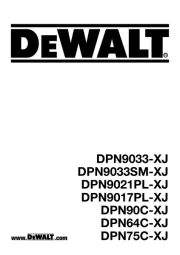
16 April 2025

23 September 2024

23 September 2024
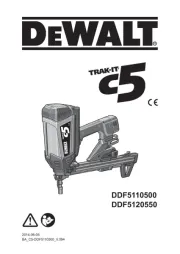
15 Juli 2024
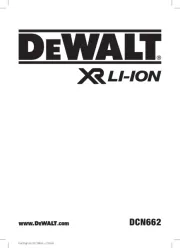
25 Juni 2024
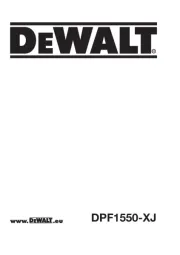
25 Juni 2024

25 Juni 2024
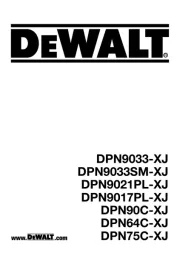
25 Juni 2024
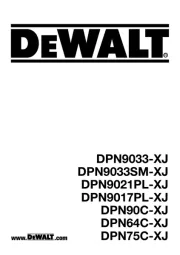
25 Juni 2024

24 Juni 2024
Handleiding Nietmachine
- Makita
- Bosch
- Powerplus
- Dedra
- Full Boar
- Rexel
- Workzone
- Worx
- Surtek
- Hikoki
- Silverline
- Metabo
- Black Decker
- Total
- Leitz
Nieuwste handleidingen voor Nietmachine
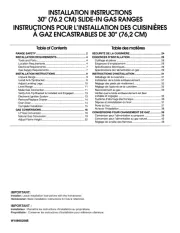
10 September 2025
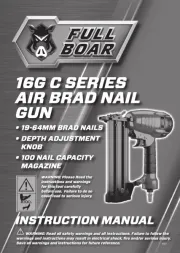
2 September 2025
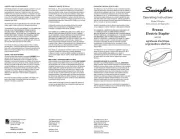
2 September 2025
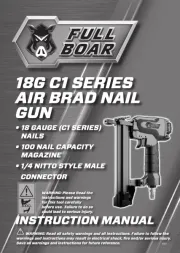
1 September 2025
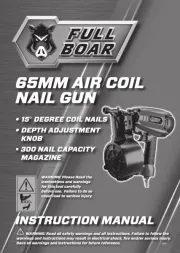
1 September 2025
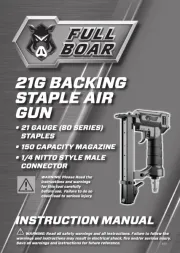
1 September 2025
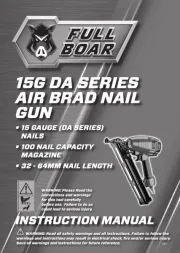
1 September 2025
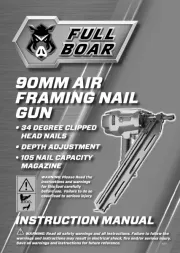
1 September 2025
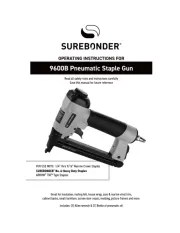
26 Augustus 2025

19 Augustus 2025